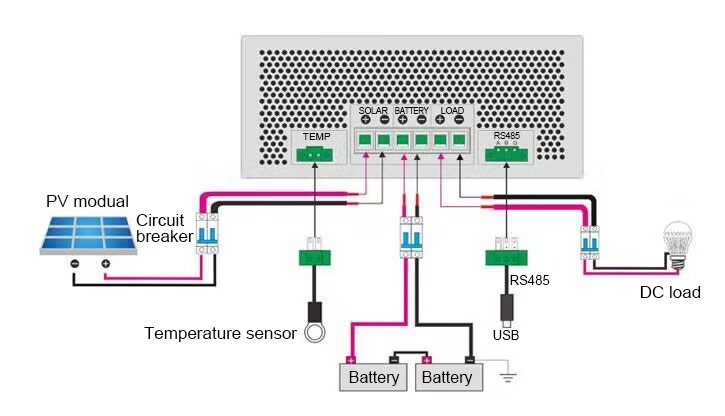A solar charge controller is used to manage the power from the solar cells to charge the batteries and supply the load in the solar power system. The charge controller protects the batteries from overcharging or deep discharging, to guarantee the safety of the batteries, increase the service life of batteries, and then improve the solar system performance. It's worth doing more investigation in your solar system for best sizing a proper solar charge controller. It is the key to longer life and higher efficiency for your battery bank.
How to size a solar charge controller?
Sizing a solar charge controller involves determining the appropriate specifications to ensure it effectively manages the power flowing from your solar panels to your battery bank. This can be done by indicating 2 parameters as follows:
Charge controller rated current
You should know that the solar charge controller's rated current refers to its output current, not the input current coming from the solar array. So, suppose you have a solar array of 3500W its operating voltage is 96V and you have a battery bank of 48VDC, so to indicate the charge controller-rated current, let us apply the power equation: P = V X I. Then I = 3500/48 = 72.91A and by taking into account the possibility of solar panels to provide higher power due to sunny days or reflecting lights coming from any outer source like water or snow, we should apply 25% safety factor, then charge controller rated current = 72.91 x 1.25 = 91.13A. Consequently, we should choose/install a 95A or 100A charge controller in this system.
Maximum solar array DC voltage
The MPPT solar charge controller has a max input DC voltage limit that should be continuously larger than the solar array's max DC output voltage, it's not allowed to be exceeded, that is the condition. Common system voltages are 12V, 24V, or 48V. This is typically determined by your battery bank configuration and the type of system you're using.
To achieve that, you need to be sure that the open circuit voltage of the whole solar array will not go above this limit. Also, you should have a certain margin above the open circuit voltage value to be on the safe side as the open circuit voltage may increase due to cold weather. So, we recommend taking a safety factor of 25%.
Suppose you have 12 solar modules forming 4 strings (3 modules will be connected in series) and the module open circuit voltage is 32V, then the whole solar array open circuit voltage will be 96VDC, taking 25% safety factor, then max safety DC voltage limit will be: 120V, consequently, we need to choose the controller max DC voltage limit to be 125V or 130V.
Choose the type of charge controller
PWM (Pulse Width Modulation): More affordable, suitable for smaller systems with consistent sunlight and no shading.
MPPT (Maximum Power Point Tracking): More efficient, better for larger systems, systems with variable shading, or higher voltage panels.
Verify compatibility with solar panel voltage
Ensure the solar charge controller can handle the open-circuit voltage (Voc) of your solar array. This is particularly important for MPPT controllers, which often handle higher voltages.
Example: If your solar panel's Voc is 22V, and you have 3 panels in series:
Total Voc=3×22V=66V
Total Voc=3×22V=66V
Ensure the charge controller can handle this voltage, ideally with a margin for safety (e.g., a controller rated for at least 75V).
Additional features and considerations
Load control: Some charge controllers have load terminals for DC loads.
Battery compatibility: Ensure the controller is compatible with your battery type (e.g., AGM, GEL, Lithium).
Temperature compensation: Useful for maintaining battery health in varying temperatures.
If you still have questions about selecting the right charge controller for your solar system, please feel free to contact us.

but after browsing through a few of the articles
I realized it's new to me. Anyhow, I'm certainly delighted I came across it and I'll be book-marking it and checking back often! donate for ukraine